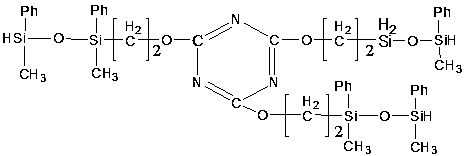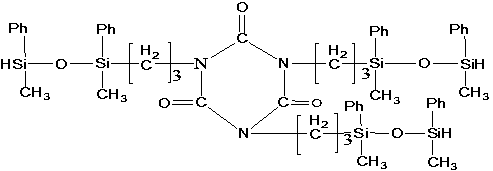A high-refractive-index, high-toughness, vulcanization-resistant LED encapsulation silicone
A technology of LED packaging and high refractive index, applied in adhesives, non-polymer adhesive additives, adhesive additives, etc., can solve the problems of easy cracking of packaging materials, impact dead lights, and reduced material toughness, and achieve vulcanization resistance. The effect of increasing and decreasing internal stress and increasing cross-linking density
- Summary
- Abstract
- Description
- Claims
- Application Information
AI Technical Summary
Problems solved by technology
Method used
Image
Examples
Embodiment 1
[0038] Preparation of component A: Weigh 80 parts of methyl phenyl vinyl silicone resin, 14.9 parts of vinyl methyl phenyl polysiloxane, 0.1 part of platinum-based catalyst, and 5 parts of adhesive. , that is, the A component is obtained;
[0039] Preparation of component B: Weigh 19.7 parts of methylphenyl vinyl silicone resin, 70 parts of methylphenyl hydrogen-containing silicone resin, 10 parts of hydrogen-containing toughening crosslinking agent, and 0.3 part of inhibitor. Add in the mixer one by one, mix and stir evenly to obtain the B component;
[0040] When using, mix the A component and the B component evenly according to the weight ratio of 5:1, vacuum defoaming for 20 minutes, dispense or pour glue on the to-be-packaged part, and first heat it at 80°C for 1 hour , and then heated at 150 ° C for 4 hours.
Embodiment 2
[0042] Preparation of component A: Weigh 88.7 parts of methyl phenyl vinyl silicone resin, 10 parts of vinyl methyl phenyl polysiloxane, 0.3 part of platinum-based catalyst, and 1 part of adhesive, and then add them into the mixer and mix them evenly , that is, the A component is obtained;
[0043] Preparation of component B: Weigh 19.9 parts of methylphenyl vinyl silicone resin, 80 parts of methylphenyl hydrogen-containing silicone resin, 1 part of hydrogen-containing toughening crosslinking agent, and 0.1 part of inhibitor. Add in the mixer one by one, mix and stir evenly to obtain the B component;
[0044] When using, mix the A component and B component evenly according to the weight ratio of 5:1, vacuum defoaming for 20 minutes, dispense or pour glue on the to-be-packaged part, and first heat it at 100 ° C for 1 hour , and then heated at 160 ° C for 4 hours.
Embodiment 3
[0046] Preparation of component A: Weigh 85 parts of methyl phenyl vinyl silicone resin, 12.3 parts of vinyl methyl phenyl polysiloxane, 0.2 part of platinum-based catalyst, and 2.5 parts of adhesive. , that is, the A component is obtained;
[0047] Preparation of component B: Weigh 19.3 parts of methylphenyl vinyl silicone resin, 75 parts of methylphenyl hydrogen-containing silicone resin, 5.5 parts of hydrogen-containing toughening crosslinking agent, and 0.2 part of inhibitor. Add in the mixer one by one, mix and stir evenly to obtain the B component;
[0048] When using, mix the A component and the B component evenly according to the weight ratio of 5:1, vacuum defoaming for 20 minutes, dispense or pour glue on the to-be-packaged part, and first heat it at 120 ° C for 1 hour , and then heated at 150 ° C for 4 hours.
PUM
| Property | Measurement | Unit |
|---|---|---|
| refractive index | aaaaa | aaaaa |
Abstract
Description
Claims
Application Information
 Login to View More
Login to View More - R&D
- Intellectual Property
- Life Sciences
- Materials
- Tech Scout
- Unparalleled Data Quality
- Higher Quality Content
- 60% Fewer Hallucinations
Browse by: Latest US Patents, China's latest patents, Technical Efficacy Thesaurus, Application Domain, Technology Topic, Popular Technical Reports.
© 2025 PatSnap. All rights reserved.Legal|Privacy policy|Modern Slavery Act Transparency Statement|Sitemap|About US| Contact US: help@patsnap.com



